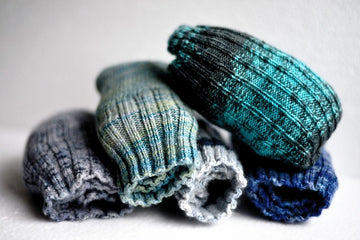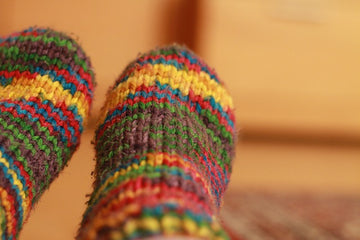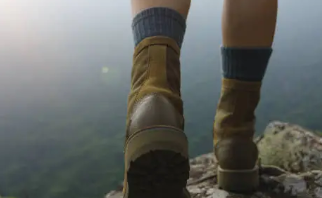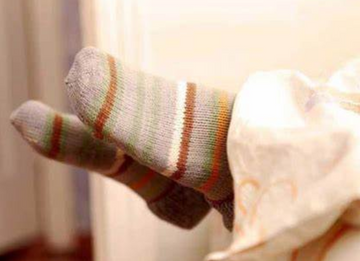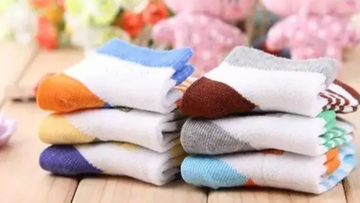
Cleaning white socks effectively requires the right techniques to maintain their brightness and durability. From using borax and baking soda to understanding the appropriate washing temperatures, each method plays a crucial role in ensuring your socks remain clean and pristine. This guide explores various cleaning methods tailored to white socks, offering insights into how to tackle stains and preserve fabric quality.
How to Clean White Socks
Borax
Preparation: Add half a cup of borax per gallon of water in a bucket, sink, or bathtub. Make sure the borax dissolves completely.
Soaking: Submerge your white socks in the borax solution and let them soak for at least one hour. For heavily stained or very dingy socks, longer soaking times (even overnight) can be more effective.
Washing: After soaking, wash the socks as usual in your washing machine with detergent. Borax can be used alongside your regular detergent without any issues.
Drying: Air-dry or tumble dry your socks as per usual recommendations.
Tips for Using Borax Safely
Check your socks' care labels to ensure they are compatible with borax.
While borax is generally safe for most fabrics, avoid using excessive amounts. Follow the recommended proportions for soaking.
Store borax safely away from children and pets, as it can be harmful if ingested.
Baking Soda
Baking soda is a versatile and effective cleaning agent that can help restore the brightness of your white socks. To use baking soda, follow these steps:
- Fill a basin with warm water.
- Add 2-3 tablespoons of baking soda and mix until dissolved.
- Soak the white socks in the solution for at least 30 minutes.
- Gently rub the socks to loosen dirt and stains.
- Rinse thoroughly with clean water and allow the socks to air dry.
Boiling
Boiling your white socks can help remove stubborn stains and sanitize them. Here’s how to do it:
- Fill a large pot with water and bring it to a boil.
- Add the white socks to the boiling water.
- Boil the socks for 10-15 minutes, stirring occasionally with a wooden spoon.
- Carefully remove the socks from the pot and rinse them under cold water.
- Wash the socks as usual with your preferred laundry detergent.
Laundry Soap
Using laundry soap is a traditional yet effective method for cleaning white socks. Follow these steps:
- Wet the socks with warm water.
- Apply laundry soap directly to the stains and areas with heavy dirt.
- Rub the fabric together or use a soft brush to scrub the socks.
- Let the socks sit for about 10 minutes to allow the soap to penetrate the fibers.
- Rinse the socks thoroughly with clean water and launder as usual.
Lemon Juice
Lemon juice is a natural bleaching agent that can help whiten your socks. Here’s how to use it:
- Fill a basin with warm water.
- Squeeze the juice of 2-3 lemons into the water.
- Add the white socks to the lemon water solution.
- Let the socks soak for at least 1 hour, preferably in direct sunlight.
- Remove the socks, rinse them with clean water, and wash them as usual.
Vinegar
White vinegar is excellent for removing odors and stains from white socks. Follow these steps:
- Fill a basin with warm water.
- Add 1 cup of white vinegar and mix well.
- Soak the white socks in the solution for at least 30 minutes.
- Gently rub the socks to loosen any dirt and stains.
- Rinse thoroughly with clean water and wash as usual.
Rice Water
Rice water is a natural cleaning agent commonly used in the kitchen. To clean white socks with rice water:
- Save the water after rinsing rice.
- Soak the dirty white socks in the rice water for 20 minutes.
- After soaking, wash the socks as you normally would.
84 Disinfectant
84 disinfectant is effective in whitening yellowed socks, but it must be used with caution due to its corrosive properties:
- Add a few drops of 84 disinfectant to a basin of water.
- Soak the yellowed white socks in the solution for a short period.
- Do not use this method on colored socks as it can cause fading.
- Wear rubber gloves to protect your hands while handling the disinfectant.
- Rinse the socks thoroughly and wash them as usual.
Hydrogen Peroxide
Hydrogen peroxide can help whiten socks and remove stains. Use a 3% concentration for best results:
- Fill a basin with warm water.
- Add a small amount of hydrogen peroxide (3% concentration).
- Soak the white socks in the solution for about 30 minutes.
- Gently rub the socks to remove stains.
- Rinse thoroughly with clean water and wash as usual.
Washing Powder + Soap
Combining washing powder and soap can be effective for yellowed socks:
- Soak the yellowed socks in warm water mixed with washing powder for about 10 minutes.
- Rub the socks with your hands to remove dirt.
- Rinse the socks twice with clean water.
- Apply soap directly to the socks (do not dilute with water) and let them sit for about 5 minutes.
- Rub the socks vigorously, then rinse thoroughly with clean water.
How to Clean Different Material Socks
Cotton socks are durable and can withstand a variety of cleaning methods. Here's a simple way to clean them:
Soak the socks in clean water for a while to loosen dirt and stains.
Add a small amount of laundry detergent to the water.
Pour hot water over the socks and let them soak for a few minutes.
Scrub the socks thoroughly to remove any remaining dirt.
Rinse with clean water and allow them to air dry.
Fiber socks are unique in that they have self-cleaning properties and can absorb harmful substances without retaining unpleasant odors. To clean fiber socks:
Soak the socks in clean water.
Due to their self-cleaning nature, simply rubbing them gently will often suffice.
If the socks are stained with oil, they will separate from the fibers when exposed to water.
No laundry detergent is needed; just rinse thoroughly with water and air dry.
Silk stockings and nylon socks are delicate and require gentle handling to avoid damage. Follow these steps:
Fill a basin with soapy water below 40 degrees Celsius (104 degrees Fahrenheit).
Soak the stockings or socks in the soapy water.
Gently scrub the fabric to clean it, avoiding any harsh rubbing that could cause tearing.
Rinse thoroughly with cool water.
Gently squeeze out excess water without wringing and lay flat to dry.
Wool socks need to be washed carefully to maintain their softness and avoid shrinkage. Here’s how to clean them:
Prepare a neutral soap solution by dissolving a small amount of neutral soap in water.
Soak the wool socks in the soap solution for a few minutes.
Gently scrub the socks with your hands to clean them, being careful not to rub too hard.
Rinse the socks thoroughly with lukewarm water.
Press out excess water without wringing and lay flat to dry, reshaping them as needed.
Should you bleach white socks?
Using bleach on white socks can be effective, but it must be done carefully to avoid damaging the fabric. If your white socks are heavily stained or have turned dingy, bleaching can help restore their whiteness. Ensure the socks are made from bleach-safe materials (cotton or polyester). Avoid bleaching wool, silk, or spandex blends.
Why do my white socks still look dirty after washing?
White socks may still look dirty after washing due to reasons like not pre-treating stains, using too little or ineffective detergent, washing in cold water, overloading the washing machine, skipping bleach or whitening agents, hard water, detergent residue buildup, insufficient rinsing, or improper drying methods.
Will borax whiten socks?
Yes, borax can help whiten socks and other washable items. Borax, also known as sodium borate, is a natural mineral compound and household cleaner that has several useful properties in laundry care, including whitening and brightening clothes.
- Stain Removal: Borax helps to break down and lift stains from fabrics, including dirt and oils that can cause socks to look dingy.
- Brightening: It enhances the cleaning power of your detergent, which can lead to brighter whites after washing.
- Softening Water: Borax acts as a water softener, helping detergent work more effectively in hard water conditions. Hard water minerals can sometimes dull whites, and borax helps counteract this effect.
Is it best to wash white socks inside out?
Yes, washing white socks inside out is generally recommended.
Turning socks inside out exposes the inner fabric where dirt, sweat, and oils accumulate. This allows the detergent to directly target and clean these areas more effectively.
Sweat and bacteria tend to build up on the inside of socks. Washing them inside out helps to remove these sources of odor more thoroughly.
Washing socks inside out can help prevent the outside fabric from pilling or getting snagged during washing and drying.
It can also help preserve the elasticity of the sock’s cuffs and prevent them from stretching out over time.
Should white socks be washed in hot or cold water?
Generally, white socks, especially those made of cotton or polyester blends, can be washed in hot water to effectively remove dirt, oils, and bacteria. Hot water helps to dissolve these substances better than cold water, providing a more thorough clean.
Hot water (typically around 140-150°F or 60-65°C) is suitable for washing white cotton socks. It helps to break down oils and dirt effectively.
Polyester blends can also be washed in hot water, as it helps to remove sweat and oils.
It’s generally recommended to wash colored socks in cold water to prevent colors from fading and bleeding. Cold water (around 80-85°F or 25-30°C) is gentler on dyes and helps to maintain the vibrancy of colored socks.
Wool socks should always be washed in cold water to prevent shrinking and felting of the wool fibers. Use a gentle detergent suitable for wool or a detergent specifically labeled for delicate fabrics.
Can you wash white socks with black stuff?
It's generally not recommended to wash white socks with items that have dark colors, especially if those dark items are new or have a tendency to bleed dye.
Dark-colored items, especially new ones, can release dye during washing. This dye can transfer onto white socks, causing them to become stained or discolored.
Even older dark-colored items may still lose dye with each wash, especially if they weren’t properly washed and treated for colorfastness before.
To keep white socks looking bright and clean, it's best to wash them separately from items that could potentially transfer dye.
How do you get color out of white socks?
If white socks accidentally pick up dye, you can use household bleach to remove the color. Ensure the socks do not have a "do not bleach" symbol on their care label. Prepare a diluted bleach solution and soak the socks in it for about 15 minutes, gently agitating them occasionally. Rinse thoroughly with cold water afterward and proceed with a regular wash cycle using mild detergent. Air-dry the socks once clean.
Should you put socks in the dryer?
To preserve the quality and integrity of socks, especially those made from delicate materials like wool, it's generally recommended to avoid machine drying. Air drying is preferred as it prevents shrinkage, maintains fabric integrity by reducing wear and tear, and helps retain the socks' elasticity over time. Lay socks flat to dry on a towel or drying rack in a well-ventilated area at room temperature. This method not only ensures socks keep their shape but also extends their lifespan by minimizing exposure to excessive heat and mechanical agitation from dryers.
What temperature do you wash dirty white socks?
For washing dirty white socks, it's generally recommended to use a water temperature that is warm enough to effectively clean the socks but not so hot that it compromises their durability or color.
A temperature range of about 30-40 degrees Celsius (86-104 degrees Fahrenheit) is typically suitable for washing white socks. This temperature helps to dissolve dirt and oils effectively.
Washing socks in water hotter than 40 degrees Celsius (104 degrees Fahrenheit) can potentially damage the fabric over time, leading to shrinkage and color fading, especially for cotton and delicate fabrics.
Final Words
Maintaining the cleanliness and longevity of white socks involves careful attention to cleaning methods and materials. Whether utilizing borax for whitening, air-drying to prevent shrinkage, or choosing the correct washing temperature, these practices help uphold the socks' appearance and texture. By following these guidelines, you can ensure that your white socks stay fresh, bright, and comfortable wear after wear. Efficient cleaning not only removes stains but also enhances overall sock hygiene, contributing to a longer lifespan and continued satisfaction.
Read More:
Why Do We Wear Socks
Do You Wear Socks with Climbing Shoes
What Color Socks with Brown Shoes
What Socks to Wear with Loafers
What are Grip Socks
What Socks to Wear with Cowboy Boots
Are Wool Socks Good for Summer




